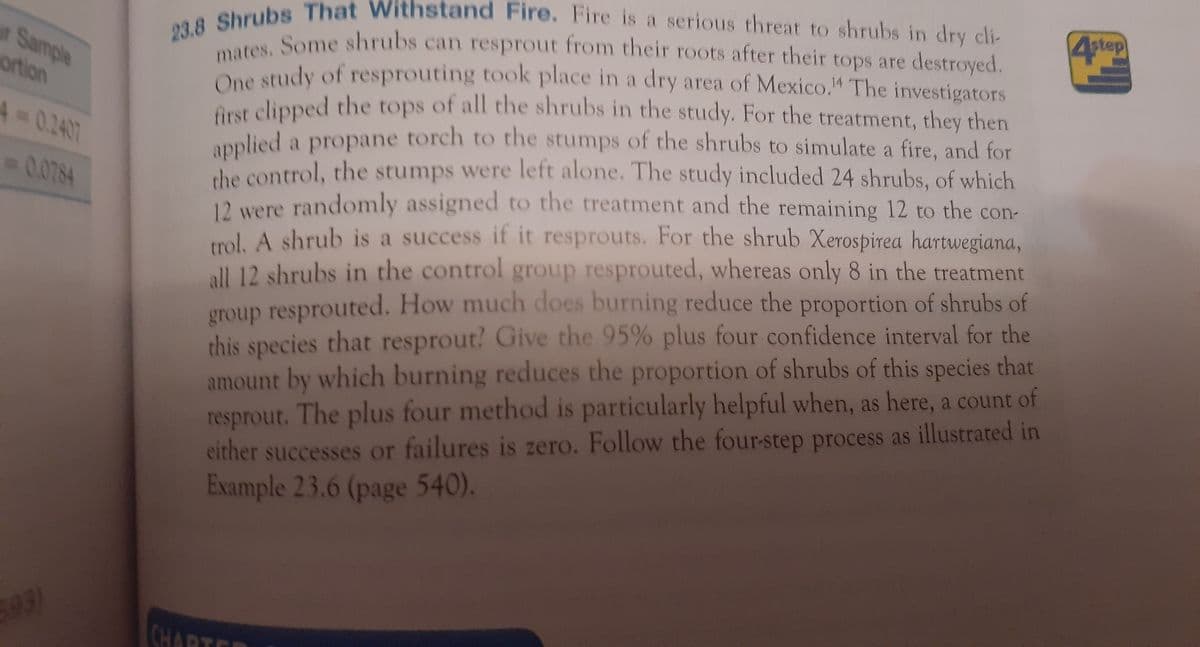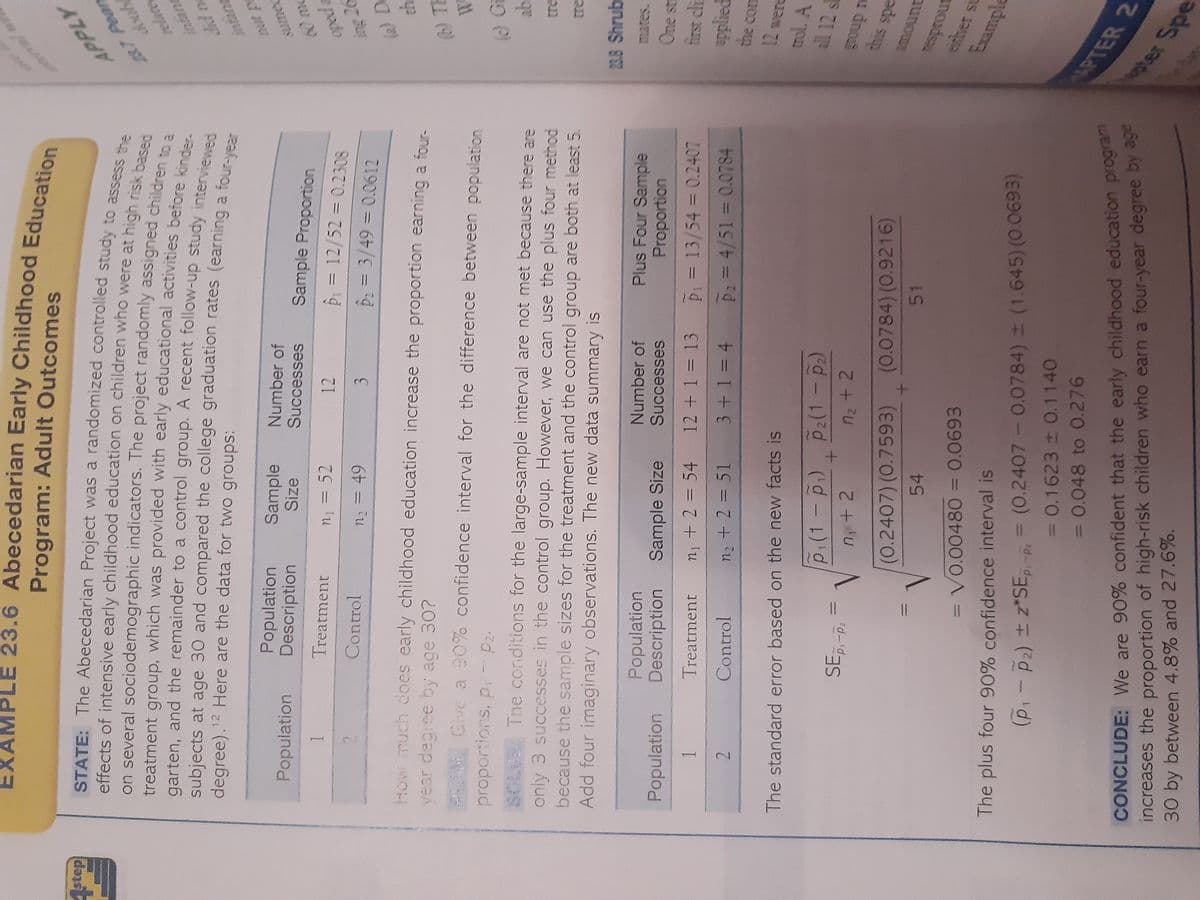mates. Some shrubs can resprout from their roots after their tops are destroyed. One study of resprouting took place in a dry area of Mexico." The investigators Arst clipped the tops of all the shrubs in the study. For the treatment, they then applied a propane torch to the stumps of the shrubs to simulate a fire, and for the control, the stumps were left alone. The study included 24 shrubs, of which 12 were randomly assigned to the treatment and the remaining 12 to the con- rol. A shrub is a success if it resprouts. For the shrub Xerospirea hartwegiana, all 12 shrubs in the control group resprouted, whereas only 8 in the treatment group resprouted. How much does burning reduce the proportion of shrubs of this species that resprout? Give the 95% plus four confidence interval for the amount by which burning reduces the proportion of shrubs of this species that resprout. The plus four method is particularly helpful when, as here, a count of either successes or failures is zero. Follow the four-step process as illustrated im Example 23.6 (page 540).
mates. Some shrubs can resprout from their roots after their tops are destroyed. One study of resprouting took place in a dry area of Mexico." The investigators Arst clipped the tops of all the shrubs in the study. For the treatment, they then applied a propane torch to the stumps of the shrubs to simulate a fire, and for the control, the stumps were left alone. The study included 24 shrubs, of which 12 were randomly assigned to the treatment and the remaining 12 to the con- rol. A shrub is a success if it resprouts. For the shrub Xerospirea hartwegiana, all 12 shrubs in the control group resprouted, whereas only 8 in the treatment group resprouted. How much does burning reduce the proportion of shrubs of this species that resprout? Give the 95% plus four confidence interval for the amount by which burning reduces the proportion of shrubs of this species that resprout. The plus four method is particularly helpful when, as here, a count of either successes or failures is zero. Follow the four-step process as illustrated im Example 23.6 (page 540).
Glencoe Algebra 1, Student Edition, 9780079039897, 0079039898, 2018
18th Edition
ISBN:9780079039897
Author:Carter
Publisher:Carter
Chapter10: Statistics
Section10.3: Measures Of Spread
Problem 1GP
Related questions
Question
23.8 is what needs answerd the other is just info for it please use the calculator method

Transcribed Image Text:4step
23.8 Shrubs That Withstand Fire. Fire is a serious threat to shrubs in dry cli
mates. Some shrubs can resprout from their roots after their tops are destroyed.
Sample
De study of resprouting took place in a dry area of Mexico." The investigators
Aust clipped the tops of all the shrubs in the study. For the treatment, they then
ortion
applied a propane torch to the stumps of the shrubs to simulate a fire, and for
he control, the stumps were left alone. The study included 24 shrubs, of which
12 were randomly assigned to the treatment and the remaining 12 to the con-
trol. A shrub is a success if it resprouts. For the shrub Xerospirea hartwegiana,
all 12 shrubs in the control group resprouted, whereas only 8 in the treatment
group resprouted. How much does burning reduce the proportion of shrubs of
this species that resprout? Give the 95% plus four confidence interval for the
amount by which burning reduces the proportion of shrubs of this species that
resprout. The plus four method is particularly helpful when, as here, a count of
either successes or failures is zero. Follow the four-step process as illustrated in
Example 23.6 (page 540).
A3D0.2407
0.0784
CHARTER

Transcribed Image Text:23.6 Abecedarian Early Childhood Education
Program: Adult Outcomes
step
STATE: The Abecedarian Project was a randomized controlled study to assess
on several sociodemographic indicators. The project randomly assigned children
treatment group, which was provided with early educational activities before kea
garten, and the remainder to a control group. A recent follow-up study intervieed
subjects at age 30 and compared the college graduation rates (earning a
degree).12 Here are the data for two groups:
28.7 Pear
relaces
infan
infant
Population
Description
neat p
Sample
Size
Number of
Successes
Population
sumer
Sample Proportion
Treatment
n, = 52
Pi = 12/52 = 0.2308
1.
12
%3D
%3D
Control
n2 = 49
P2 = 3/49% 3D 0.0612
2.
How much does early childhood education increase the proportion earning a four-
year degree by age 30?
DA Cive a 90% confidence interval for the difference between population
proportions, p, - P2.
(6) TH
) Gi
SOLUE Tne conditions for the large-sample interval are not met because there are
oniy 3 successes in the control group. However, we can use the plus four method
because the sample sizes for the treatment and the control group are both at least 5.
Add four imaginary observations. The new data summary is
23.8 Shrub
Population
Description
Number of
Plus Four Sample
Proportion
mates.
Population
Sample Size
Successes
One str
1
Treatment n, + 2 = 54 12 + 1 = 13
= 13/54 = 0.2407
n + 2 = 51 3+1 = 4 2 = 4/51 = 0.0784
%3D
%3D
Control
%3D
%3D
2.
The standard error based on the new facts is
trol. A
al 12 s
Pi(1-P) P2(1- pa)
SEp-P:
n+ 2
n2 + 2
(0.2407)(0.7593)
1 dnous
(0.0784) (0.9216)
unoue
either su
54
51
=V0.00480 = 0.0693
The plus four 90% confidence interval is
(P-P2) ± z*SE, -p, = (0.2407 - 0.0784) (1.645) (0.0693)
= 0.1623 0.1140
CONCLUDE: We are 90% confident that the early childhood education progra
increases the proportion of high-risk children who earn a four-year degree by age
30 by between 4.8% and 27.6%.
=0.048 to 0.276
APTER 2
pter Sipe
Expert Solution
This question has been solved!
Explore an expertly crafted, step-by-step solution for a thorough understanding of key concepts.
This is a popular solution!
Trending now
This is a popular solution!
Step by step
Solved in 2 steps with 1 images

Knowledge Booster
Learn more about
Need a deep-dive on the concept behind this application? Look no further. Learn more about this topic, statistics and related others by exploring similar questions and additional content below.Recommended textbooks for you

Glencoe Algebra 1, Student Edition, 9780079039897…
Algebra
ISBN:
9780079039897
Author:
Carter
Publisher:
McGraw Hill

Holt Mcdougal Larson Pre-algebra: Student Edition…
Algebra
ISBN:
9780547587776
Author:
HOLT MCDOUGAL
Publisher:
HOLT MCDOUGAL

College Algebra (MindTap Course List)
Algebra
ISBN:
9781305652231
Author:
R. David Gustafson, Jeff Hughes
Publisher:
Cengage Learning

Glencoe Algebra 1, Student Edition, 9780079039897…
Algebra
ISBN:
9780079039897
Author:
Carter
Publisher:
McGraw Hill

Holt Mcdougal Larson Pre-algebra: Student Edition…
Algebra
ISBN:
9780547587776
Author:
HOLT MCDOUGAL
Publisher:
HOLT MCDOUGAL

College Algebra (MindTap Course List)
Algebra
ISBN:
9781305652231
Author:
R. David Gustafson, Jeff Hughes
Publisher:
Cengage Learning
